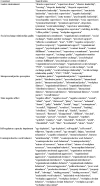Unbalanced, Unfair, Unhappy, or Unable? Theoretical Integration of Multiple Processes Underlying the Leader Mistreatment-Employee CWB Relationship with Meta-Analytic Methods
- PMID: 35966893
- PMCID: PMC9358611
- DOI: 10.1177/15480518211066074
Unbalanced, Unfair, Unhappy, or Unable? Theoretical Integration of Multiple Processes Underlying the Leader Mistreatment-Employee CWB Relationship with Meta-Analytic Methods
Abstract
Although a litany of theoretical accounts exists to explain why mistreated employees engage in counterproductive work behaviors (CWBs), little is known about whether these mechanisms are complementary or mutually exclusive, or the effect of context on their explanatory strength. To address these gaps, this meta-analytic investigation tests four theoretically-derived mechanisms simultaneously to explain the robust relationship between leader mistreatment and employee CWB: (1) a social exchange perspective, which argues that mistreated employees engage in negative reciprocal behaviors to counterbalance experienced mistreatment; (2) a justice perspective, whereby mistreated employees experience moral outrage and engage in retributive behaviors against the organization and its members; (3) a stressor-emotion perspective, which suggests that mistreated employees engage in CWBs to cope with their negative affect; and (4) a self-regulatory perspective, which proposes that mistreated employees are simply unable to inhibit undesirable behaviors. Moreover, we also examine whether the above model holds across cultures that vary on power distance. Our meta-analytic structural equation model demonstrated that all but the justice mechanism significantly mediated the relationship between leader mistreatment and employee CWBs, with negative affect emerging as the strongest explanatory mechanism in both high and low power distance cultures. Given these surprising results, as the stressor-emotion perspective is less frequently invoked in the literature, this paper highlights not only the importance of investigating multiple mechanisms together when examining the leader mistreatment-employee CWB relationship, but also the need to develop more nuanced theorizing about these mechanisms, particularly for negative affect.
Keywords: counterproductive work behaviors; depleted self-regulatory capacity; justice; leader mistreatment; negative affect; social exchange.
© The Authors 2021.
Conflict of interest statement
Declaration of Conflicting Interests: The author(s) declared no potential conflicts of interest with respect to the research, authorship, and/or publication of this article.
Figures






Similar articles
-
Effects of Employee-Artificial Intelligence (AI) Collaboration on Counterproductive Work Behaviors (CWBs): Leader Emotional Support as a Moderator.Behav Sci (Basel). 2025 May 17;15(5):696. doi: 10.3390/bs15050696. Behav Sci (Basel). 2025. PMID: 40426473 Free PMC article.
-
The Work-Family Spillover Effects of Customer Mistreatment for Service Employees: The Moderating Roles of Psychological Detachment and Leader-Member Exchange.Front Psychol. 2019 Sep 18;10:2107. doi: 10.3389/fpsyg.2019.02107. eCollection 2019. Front Psychol. 2019. PMID: 31620050 Free PMC article.
-
Toward a Typology of Counterproductive Employees: A Person-Oriented Investigation of Counterproductive Work Behavior.J Pers Oriented Res. 2023 Jun 17;9(1):1-16. doi: 10.17505/jpor.2023.25256. eCollection 2023. J Pers Oriented Res. 2023. PMID: 37389030 Free PMC article.
-
Do other-reports of counterproductive work behavior provide an incremental contribution over self-reports? A meta-analytic comparison.J Appl Psychol. 2012 May;97(3):613-36. doi: 10.1037/a0026739. Epub 2011 Dec 26. J Appl Psychol. 2012. PMID: 22201245 Review.
-
Justice at the millennium, a decade later: a meta-analytic test of social exchange and affect-based perspectives.J Appl Psychol. 2013 Mar;98(2):199-236. doi: 10.1037/a0031757. J Appl Psychol. 2013. PMID: 23458336 Review.
References
-
- *Indicated with an asterisk were included in our meta-analysis and to distinguish them from papers that are cited in-text.
-
- Andersson L. M., Pearson C. M. (1999). Tit for tat? The spiraling effect of incivility in the workplace. Academy of Management Review, 24(3), 452-471. 10.5465/amr.1999.2202131 - DOI
LinkOut - more resources
Full Text Sources
